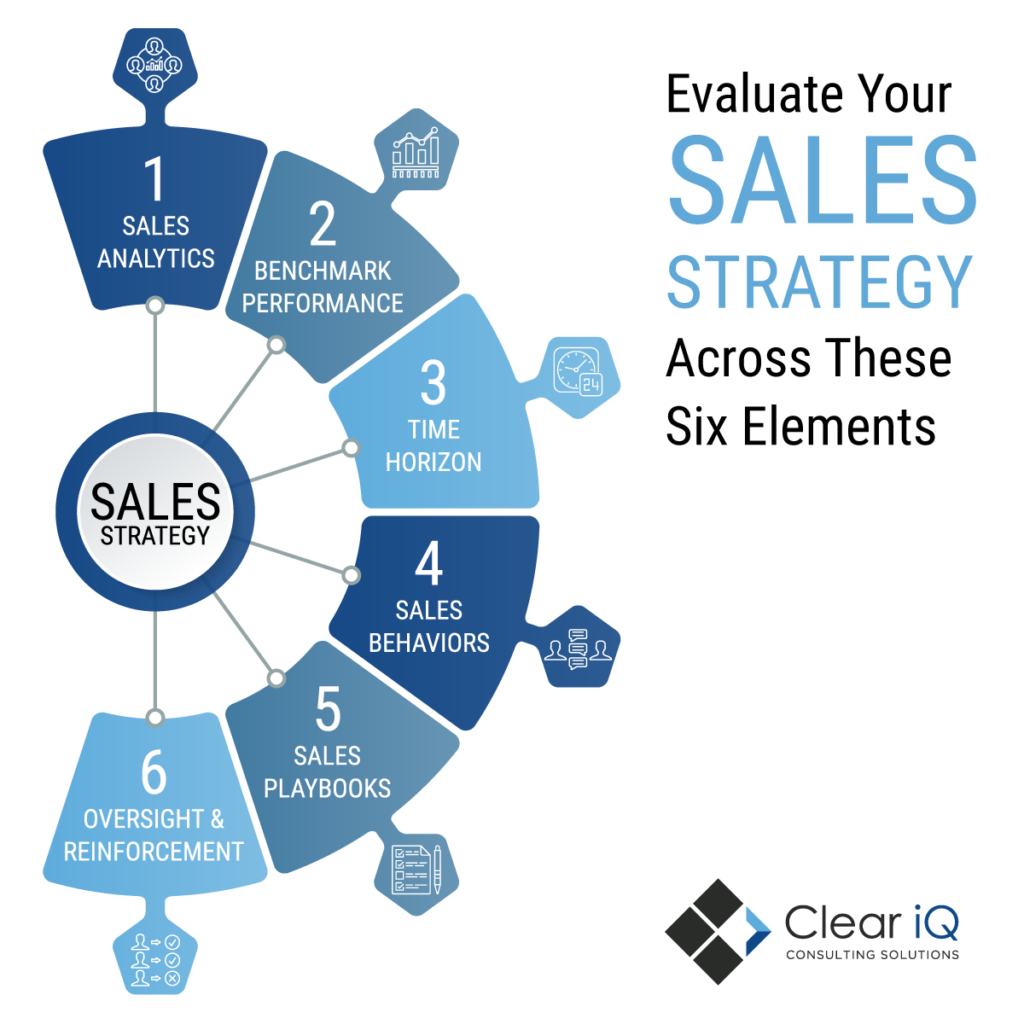
When analyzing your overall Go to Market Strategy, your organization must also carefully assess your sales strategy. This, along with managing and assessing your sales teams’ actions and progress, helps you fully understand how effective you are in sustaining and realizing sales growth.
Consider the following questions when conducting your sales assessment:
- Beyond sales performance, where are you winning, and where are you losing; by product, customer, and territory?
- Where are you gaining new customers?
- How do you measure the results of your sales resources?
A comprehensive sales strategy seeks to balance current-year objectives with long-term growth. Within each element of the sales strategy, we focus on guiding principles to overcome common pitfalls.
Clear iQ evaluates sales strategies across six elements, to answer these sales assessment questions.
1–Sales Analytics
A common pitfall with sales analytics, in particular when sales are up and people are happy, is using a top-down view. In this situation, you might focus on hitting this year’s goals and bonuses. However, this approach overlooks the wins and losses at the customer, product, and territory levels.
Bottom-up reviews tell a very different story, providing insight into your wins and losses at the customer, product, and territory levels.
2–Benchmark Performance
Benchmark performance tracking provides information on trends and products to help you determine the following:
- Which products are winning with your top clients? Which is losing?
- Are you acquiring new clients? Or are you selling primarily to your existing base?
- Who on your sales team is hunting for new business? Who is simply farming?
- What are your incentives really paying for?
One thing to remember is that year-to-date (YTD) and year-over-year (YoY) benchmarks tell only part of your team’s performance story. You should measure yourself against the truth, not only what looks best.
The right benchmark data will provide you with insight into multi-year trends, what happens before and after key events, information about how new vs traditional products perform, and more.
3–Time Horizon
Working beyond the current year’s priorities takes time and effort. While things like e-commerce, customer acquisition, and NPIs (new product introductions) are hard work now, they will pay off later.
To better understand your organization’s future, you should create a plan that tackles short-, mid-, and long-term goals vital to your three-year growth plan.
To do this, identify the top five tasks that need to happen to meet your sales goal and an additional five tasks that will aid your company’s growth.
4–Sales Behaviors
The behavior of sales personnel has a major impact on your sales strategy. Often salespeople gravitate toward what is comfortable and avoid long-term discussions to protect short-term wins.
Therefore, your organization must be willing to have difficult discussions with your sales team to identify and nurture the sales behaviors that will yield the desired outcomes of your 3-year sales strategy.
5–Sales Playbooks
Effective sales teams work from a concise sales playbook—a shareable plan that clearly identifies the who, what, when and how of your sales process. A solid sales playbook includes timelines and tangible outcomes.
If you do not have a sales playbook, work with your sales personnel to create one now. Including sales personnel in identifying your who, what, when and how sales playbook helps you gain buy-in from your critical customer-facing sales team. And provides them with a blueprint for your defined process that will result in measurable, tangible outcomes.
6–Oversight and Reinforcement
Today’s sales numbers result from your last six months of tactics and strategy. Take steps now to ensure your investment in your sales team builds the foundation for sustained customer loyalty and results.
It is okay to ask your sales team to build a plan, execute the plan, and then verify their progress against the plan to ensure success.
In the ideal situation, you will leverage your sales team to balance freedom and creativity while creating and executing your sale playbook, then follow up to verify progress.
Clear iQ’s Approach to GTM Sales Strategy
Clear iQ specializes in navigating a multi-dimensional approach to building your go-to-market (GTM) sales strategy, enabling a clear strategic vision and roadmap for steady growth. To do this, we:
- Understand growth and losses by customer, product, and territory using Sales and Revenue Analytics
- Benchmark beyond your current year bonus targets to understand trends.
- Define sales strategies to target product and customer growth
- Describe tangible behaviors to train and implement for your field and inside personnel to best support sales strategy execution
- Build sales playbooks with activities, targets, timelines, and outcomes so you can monitor progress
- Track progress of playbook execution with steady reinforcement

